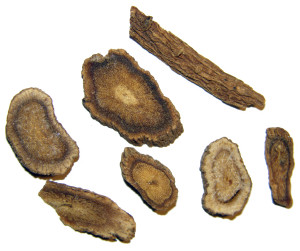It is also known as Mu Xiang, which, literally translated, means “wood aroma.” Its whole plant, in particular the rhizome, is good for health. Thanks to its extraordinary medicinal uses on activating Chi energy flow, clinically it is considered one of the 50 essential Chinese herbs and mainly used for the treatment of diseases caused by blocked Chi (for example: stomachache).
Contents
Uses
In Chinese medicine, the Ledebouriella divaricata root is classified as an herb that removes wind that can cause pain and spasm. It can be used alone or combined with other herbs as an effective herbal formula. It is also called Fangfeng in Chinese.
Benefits
Radix saussureae seu inulae health benefits has been known for thousands of years and it was first mentioned in Shen Nong Ben Cao Jing (The Divine Farmer’s Materia Medica), which is the earliest material medical extant in China. Today, it is extensively used for many conditions. The single herb is often used to treat anicteric hepatitis and chronic persistent hepatitis. And costus-based formulas treat cholecystitis, infantile enteritis, bacillary dysentery, colic, flatulence, peptic ulcer, Diarrhea Predominant Irritable Bowel Syndrome (IBS-D), and dysmenorrhea. Here are some examples.
(1). 34 cases of chronic atrophic gastritis were ever treated with the combination of costus root, Chai Hu (Bupleurum), Gua Lou Ren (Semen Trichosanthis), Ban Xia (Pinellia), Zhi Ke (Fructus Aurantii), etc. And the total effective rate was 94%.
(2). 96 cases of acute diarrhea were treated with Xiang Shen Zhi Xie Fang, which is the Combination of costus and Ku Shen (Sophora Flavescens). And the result showed that the total effective rate was 97.9%;
(3). Cholelithiasis was ever treated with the decoction consisting of Yin Chen Hao (Herba Artemisiae Scopariae), Jin Qian Cao (Gold Coin Grass), costus, Bupleurum, Fructus Aurantii, etc. And discharge rate for stones was more than 60%;
(4). Biliary colic was treated with Li Dan Tong Fu Jiao Nang, which is made of Da Huang (Rhubarb), costus, and Tian xian zi (Semen Hyoscyami). The total effective rate was 71.76%.
Cautions
The median lethal dose in rats is 300mg/kg of total lactone and 200mg/kg of dehydrocostus lactone. The maximum tolerated dose intravenously is 100mg/kg in mice and 90mg/kg in rats. Radix saussureae seu inulae root oil mixed with feed had been given to male rat with the daily dosage of 1.77mg/kg and to female with 2.17mg/kg for consecutive 90 days. And the result showed that it had no effect on the growth, blood and blood urea nitrogen. In addition, no abnormality was found in the pathologic examination of main organs. TCM wise, it shouldn’t be used in the cases of yin deficiency or insufficiency of the body fluid.
Interactions
None are recorded.
Other names
Mu Xiang
Reference
Source: SacredLotus, http://www.sacredlotus.com/go/chinese-herbs/substance/mu-xiang-costus-root-saussurea
Chineseherbshealing, http://www.chineseherbshealing.com/costus/

